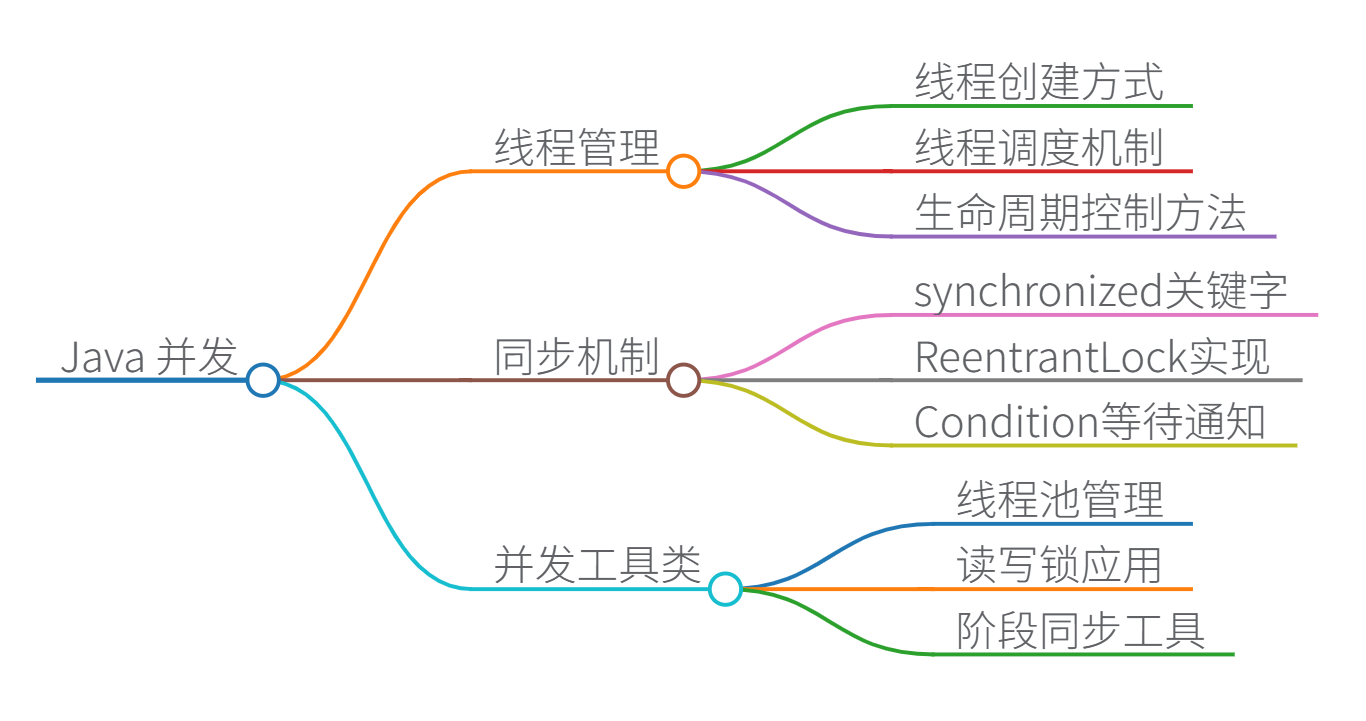在Java并发编程中,通过代码示例可以更直观地理解线程管理、同步机制和并发工具类的使用。以下是一些常见的Java并发编程示例,涵盖线程创建、同步控制、线程池、并发工具类等关键概念。
线程创建与启动
Java中创建线程的两种主要方式是继承Thread类和实现Runnable接口。这两种方式都可以用于定义线程任务并启动执行。
// 继承Thread类
public class MyThread extends Thread {
@Override
public void run() {
System.out.println("线程运行中: " + Thread.currentThread().getName());
}
public static void main(String[] args) {
new MyThread().start();
}
}
// 实现Runnable接口
public class MyRunnable implements Runnable {
@Override
public void run() {
System.out.println("线程运行中: " + Thread.currentThread().getName());
}
public static void main(String[] args) {
new Thread(new MyRunnable()).start();
}
}
线程池是一种更高效的线程管理方式,适用于并发任务较多的场景。Java提供了ExecutorService来简化线程池的使用。
import java.util.concurrent.ExecutorService;
import java.util.concurrent.Executors;
public class ThreadPoolExample {
public static void main(String[] args) {
ExecutorService executorService = Executors.newFixedThreadPool(5);
for (int i = 0; i < 10; i++) {
executorService.execute(() -> {
System.out.println("任务执行中: " + Thread.currentThread().getName());
});
}
executorService.shutdown();
}
}
线程同步机制
在多线程环境下,多个线程可能同时访问共享资源,这可能导致数据不一致。Java提供了synchronized关键字和ReentrantLock来实现线程同步。
// 使用 synchronized 关键字
public class SynchronizedExample {
private int count = 0;
public synchronized void increment() {
count++;
}
public static void main(String[] args) throws InterruptedException {
SynchronizedExample example = new SynchronizedExample();
Thread t1 = new Thread(() -> {
for (int i = 0; i < 1000; i++) {
example.increment();
}
});
Thread t2 = new Thread(() -> {
for (int i = 0; i < 1000; i++) {
example.increment();
}
});
t1.start();
t2.start();
t1.join();
t2.join();
System.out.println("最终计数值: " + example.count);
}
}
// 使用 ReentrantLock
import java.util.concurrent.locks.Lock;
import java.util.concurrent.locks.ReentrantLock;
public class ReentrantLockExample {
private int count = 0;
private Lock lock = new ReentrantLock();
public void increment() {
lock.lock();
try {
count++;
} finally {
lock.unlock();
}
}
public static void main(String[] args) throws InterruptedException {
ReentrantLockExample example = new ReentrantLockExample();
Thread t1 = new Thread(() -> {
for (int i = 0; i < 1000; i++) {
example.increment();
}
});
Thread t2 = new Thread(() -> {
for (int i = 0; i < 1000; i++) {
example.increment();
}
});
t1.start();
t2.start();
t1.join();
t2.join();
System.out.println("最终计数值: " + example.count);
}
}
使用Condition实现线程协作
Condition接口与ReentrantLock结合使用,可以实现线程间的等待/通知机制,比传统的wait()和notify()更加灵活。
import java.util.concurrent.locks.Condition;
import java.util.concurrent.locks.Lock;
import java.util.concurrent.locks.ReentrantLock;
public class ConditionExample {
private Lock lock = new ReentrantLock();
private Condition condition = lock.newCondition();
private boolean flag = false;
public void await() throws InterruptedException {
lock.lock();
try {
while (!flag) {
condition.await();
}
System.out.println("等待结束");
} finally {
lock.unlock();
}
}
public void signal() {
lock.lock();
try {
flag = true;
condition.signal();
} finally {
lock.unlock();
}
}
public static void main(String[] args) throws InterruptedException {
ConditionExample example = new ConditionExample();
Thread t1 = new Thread(() -> {
try {
example.await();
} catch (InterruptedException e) {
e.printStackTrace();
}
});
t1.start();
Thread.sleep(2000);
example.signal();
}
}
使用CountDownLatch实现线程等待
CountDownLatch是一种同步工具类,它允许一个或多个线程等待其他线程完成操作。它通过计数器来控制线程的阻塞与释放。
import java.util.concurrent.CountDownLatch;
public class CountDownLatchExample {
public static void main(String[] args) throws InterruptedException {
int threadCount = 3;
CountDownLatch latch = new CountDownLatch(threadCount);
for (int i = 0; i < threadCount; i++) {
new Thread(() -> {
System.out.println("线程 " + Thread.currentThread().getName() + " 完成任务");
latch.countDown();
}).start();
}
latch.await();
System.out.println("所有线程任务已完成");
}
}
使用CyclicBarrier实现线程阶段性同步
CyclicBarrier用于协调多个线程在某个屏障点汇合,所有线程必须到达屏障后才能继续执行。适用于并行计算中的阶段性任务同步。
import java.util.concurrent.BrokenBarrierException;
import java.util.concurrent.CyclicBarrier;
public class CyclicBarrierExample {
public static void main(String[] args) {
int parties = 3;
CyclicBarrier barrier = new CyclicBarrier(parties, () -> {
System.out.println("所有线程已到达屏障点");
});
for (int i = 0; i < parties; i++) {
new Thread(() -> {
try {
System.out.println("线程 " + Thread.currentThread().getName() + " 到达屏障");
barrier.await();
System.out.println("线程 " + Thread.currentThread().getName() + " 继续执行");
} catch (InterruptedException | BrokenBarrierException e) {
e.printStackTrace();
}
}).start();
}
}
}
使用Future和Callable实现异步计算
Callable接口与Future结合使用,可以实现带有返回值的异步任务执行。
import java.util.concurrent.*;
public class FutureExample {
public static void main(String[] args) throws ExecutionException, InterruptedException {
ExecutorService executor = Executors.newSingleThreadExecutor();
Future<Integer> future = executor.submit(() -> {
Thread.sleep(1000);
return 42;
});
System.out.println("任务执行中...");
System.out.println("任务结果: " + future.get());
executor.shutdown();
}
}
使用CompletableFuture实现异步编程
CompletableFuture是Java 8引入的异步编程工具,支持链式调用和组合多个异步任务。
import java.util.concurrent.CompletableFuture;
public class CompletableFutureExample {
public static void main(String[] args) throws ExecutionException, InterruptedException {
CompletableFuture<String> future = CompletableFuture.supplyAsync(() -> {
return "Hello";
}).thenApply(s -> s + " World");
System.out.println(future.get());
}
}
思维导图





















 1335
1335

 被折叠的 条评论
为什么被折叠?
被折叠的 条评论
为什么被折叠?








